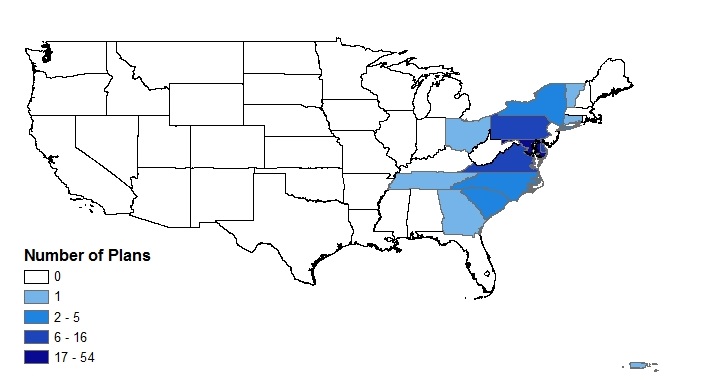Recently I was asked to compile a list of all the watershed plans and retrofit inventories the Center has been a part of since its beginning in 1992. The extent of the Center’s work surprised me, both in terms of the number of plans and the geographic reach. I thought I would share some highlights from this work through a map and a timeline. We appreciate all the partners who have supported the Center’s work on watersheds over the past 25 years!
The Center has worked on nearly 100 watershed plans and retrofit inventories. Our plans have centered heavily around our Maryland headquarters, with 54 plans completed in our home state. Virginia and Pennsylvania are next in line with 12 and 8 plans completed, respectively. We have done plans for watersheds as far away as Ontario, Canada, Puerto Rico, and the U.S. Virgin Islands. (It would be great to begin filling in the western half of this map!)
A brief timeline of Center watershed planning and retrofit work:
1994 – The Center conducts its first retrofit inventory in Westminster, Maryland
1998 – Rapid Watershed Planning Handbook published
2001 – First watershed plan in Maryland (Watts Branch watershed)
2001 – First watershed plan in Virginia (Powhatan Creek watershed)
2003 – First watershed plan in Pennsylvania (Paxton Creek watershed)
2005 – Urban Subwatershed Restoration Manual Series presents integrated framework and methods to restore urban subwatersheds
2005 – First watershed plan in Delaware (Appoquinimink River watershed)
2006 – First watershed plan in South Carolina (Kingston Lake watershed)
2007 – Urban Stormwater Retrofit Practices manual published
2008 – First (of 6) Small Watershed Action Plan for Baltimore County, MD
2008 –Two tropical watersheds plans completed in Guanica Bay (PR) and Coral Bay (USVI)
2010 – Chesapeake Bay TMDL developed; spurs great demand for retrofit assessments
2013 – Most extensive retrofit assessment completed for Arlington County, VA; process took several years and identified over 1,200 retrofits
2014 – First cooperative Chesapeake Bay Pollution Reduction Plan developed in Pennsylvania (York County)
These plans have evolved over the years to reflect new methods and changing regulatory needs. While some have been “cadillac” plans, others are smaller in scope to meet a specific need, such as identifying retrofit projects to meet TMDL requirements, or updating an existing plan to meet EPA’s “a-i” watershed planning criteria. Despite these differences, some constant features of our plans have included a focus on small watersheds, a rapid approach to plan development, close coordination with local partners and inclusion of specific and prioritized recommendations.
Director of Research, Center for Watershed Protection
Karen is a former GIS guru who now focuses primarily on applied watershed and stormwater research. She enjoys researching emerging watershed issues, analyzing watershed data, and translating technical topics into easy-to-understand guidance. Special areas of interest include impervious cover measurement and urban forestry. Karen has been with the Center since 2000, and has a B.A. in Geography from Millersville University and an M.A. in Geography from East Carolina University. She lives in Frederick County with her husband and daughters, and enjoys playing soccer, cooking, and researching her family ancestry








